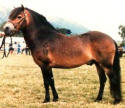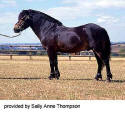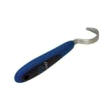|
Equine Kingdom Riding Academy
is no longer in operation. These more than 2,000 unique pages are provided for historical and educational reference. |
||
|
|
||
|
|
- Exmoor - |
|
Found mainly in Exmoor, in the southwest of Devon, the
Exmoor pony is living a semi-wild existence. Although it was at one time prolific, the breed is
now greatly reduced, and there are ongoing, strictly monitored breeding programs to ensure its continuation.
The Exmoor pony is one of the most well known feral ponies in Europe and they run free over the
moorlands, although some of them are bred at private studs. They are truly a primitive breed, exhibiting
dun coloring with a mealy muzzle and belly. When compared to the Pleistocene cave paintings of wild
horses from France and Spain, the Exmoor could suggestively be a relic of the wild horse, what with
its similarity to the Tarpan and Przewalski's horse. The Exmoor largely retained its original features,
and it has not been over influenced by other breeds due to the geographical isolation of their moorland
habitat. They are very hardy and resistant to many common equine diseases, as well as harsh weather
conditions. The Exmoor pony has several very distinctive features,
most of which have obviously evolved from environmental conditions. They have very waterproofed
coats in the winter: composed of a double layer, the under layer being short and wooly and the upper
being longer and greasy. This keeps the rain and cold out while keeping the heat next to the pony's
body. Their eyes have heavy top lids known as the "toad aye", and their tails have a fanlike growth
of bush hair at the top. They show great stamina, strength, and durability, and make excellent ponies
for children. Once every year the Exmoor are rounded up, inspected, branded with a star and the
number of their herd on the near shoulder, and the pony's number is marked on their left hindquarter.
Colts that are considered below standard for the breed are gelded. The Exmoor ponies have primitive characteristics, including
their dun coloring with black points. They have attractive heads that are wide across the forehead
and have lighter markings around the eye area. Their shoulders are sloping and they are deep and
wider through the chest, have a compact frame that is deep through the girth, and have short, strong
legs with hard hooves. Exmoor mares may not stand taller than 12.2 hh, and stallions and geldings
no more than
The Wilderness Aussie Hat Oster Hoof Pick
|











